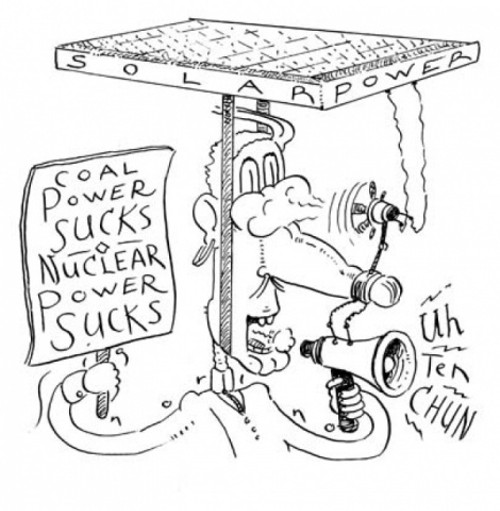Concerning your April column on whether nuclear power is safe: Nuclear power sucks. Coal power sucks more. Boggles my mind that we don’t just ditch them both and use options we know are better. —Randvek, via the Straight Dope Message Board
Ah, a believer in alternative energy. You think if we build enough windmills, install enough solar panels and distill enough ethanol from corn we’ll be able to dispense with noxious energy sources such as coal and nuclear power. I admire this noble goal. One needs to ask, however, whether it’s actually possible. Let’s browse amongst the databases and see what we can find out.
Here’s just the thing—a 2006 paper by MIT chemistry professor Daniel Nocera entitled “On the Future of Global Energy.” Nocera’s twofold ambition: one, to see how much energy the world is going to need by mid-century. Two, to figure out where we might get it. Glancing through this, Randvek, I have to be honest: Things are looking a little grim.
The first thing we learn is that, according to U.N. experts, world population is expected to reach around nine billion people by mid-century and then stabilize. The stabilization part is good, if maybe surprising to those raised on scare talk about the population explosion. The bad part is that nine billion is two billion more than we’ve got now. Given that almost half the world lives on less than $2.50 a day as it is, you can appreciate that coming up with enough food, shelter, and yes, energy to keep everybody happy is going to be a challenge.
The second thing to understand is that we damn well better keep everybody happy. The projection that world population is going to stabilize is based on the observation that as people become more urbanized and at least a little more prosperous, they have smaller families. That’s a worldwide trend. In Japan and much of Europe, in fact, the population is actually declining. The flip side is that if people remain impoverished villagers, they continue having big families and total world population keeps going up. In other words, a stable future is predicated on a modicum of global urban affluence. To the extent the world stays rural and poor, eventually much of it starves.
The third thing to understand is that the more affluent people become, the more energy they use. That doesn’t necessarily mean U.S.-scale two-SUVs-and-a-vacation-home-type affluence. Most of the world would be content with, you know, running water and some electric lights.
How much energy will that take? In 2002, Nocera points out, global energy consumption was 13.5 terawatts. What will it be in 2050? If everybody were to burn through the juice at the current U.S. rate, Nocera calculates, we’d need 102 terawatts—seven times as much. Chances of our producing that: zero.
Instead, Nocera conservatively pegs annual global energy usage circa 2050 at between 28 terawatts—which assumes average consumption at the same rate as in present-day Poland—and 35 terawatts, roughly the rate now seen in Samoa. You may say: Samoa sounds like a lifestyle I could get used to. That’s sporting of you, but it still means we’ll need about 15 to 20 more terawatts of energy than we’re consuming right now.
Where will it come from? Nocera runs through some possibilities:
* First, biomass. If we devote all the arable land on earth to energy production rather than food crops and presumably just don’t eat, we could generate 7 to 10 terawatts.
* Next, wind. If we build wind farms on 100 percent of the sufficiently windy land, we could produce 2.1 terawatts.
* Third, hydroelectric. If we dam all the remaining rivers, we could come up with 0.7 to 2 additional terawatts.
* Finally, nuclear. I know you don’t like nukes, Randvek, but the professor’s evident aim was to tote up all power sources that aren’t net emitters of greenhouse gases. He thinks we could produce 8 terawatts by constructing 8,000 nuclear power plants, which would mean one new plant every two days for the next 40 years.
Total: around 18 to 22 terawatts. In other words, if we squeeze out every available watt of alternative energy on the planet and build nukes at an impossibly aggressive rate, we’ll barely keep up with the energy needed to support even a modest standard of living for the world’s people.
In reality, we’ll need to find additional energy somewhere. Nocera’s solution is to push for a technological breakthrough in solar power, currently a relatively trivial contributor to the world energy mix. Good luck, seriously. Barring that, however, we’re stuck with more coal, oil and gas, and you know the problems with those.
My point isn’t that the situation is hopeless, although it certainly gives one pause. All I’m saying is we need to dispense with the illusory notion of “alternative” energy, which suggests we’ll get to be choosy about energy sources. Sorry, not going to happen. We’ll have to use them all.
Send questions to Cecil via StraightDope.com or write him c/o Chicago Reader, 11 E. Illinois, Chicago 60611. Subscribe to the Straight Dope podcast at the iTunes Store.
More by Cecil Adams
-
This Is the End, My Friend
This week's Straight Dope marks the last appearance of the column as the Teeming Millions have known it for the past 45 years.
- Jul 11, 2018
-
Do Brain Supplements Do Anything?
Brain Drain
- Jul 4, 2018
-
Is flying really worse for the environment than driving?
Planes and Trains
- Jun 27, 2018
- More »




